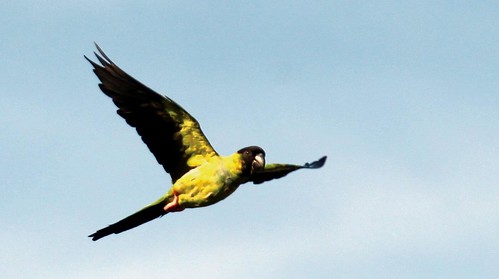Is wild parrot population on the rise?
 Friday, October 26, 2012 at 13:04
Friday, October 26, 2012 at 13:04  HARD TO MISS—A black-hooded parakeetflies around a Newbury Park neighborhood last month, where a largeflock of the exotic birds held court over the summer. Photos by RICHARD GILLARDSome mornings, Scott Bailey wakes up to the sound of birds chirping—other days, it’s the screech of parrots.
HARD TO MISS—A black-hooded parakeetflies around a Newbury Park neighborhood last month, where a largeflock of the exotic birds held court over the summer. Photos by RICHARD GILLARDSome mornings, Scott Bailey wakes up to the sound of birds chirping—other days, it’s the screech of parrots.
“It sounds like you’re in the Amazon jungle,” Bailey said. “They’re big and they’re loud. You can’t miss them.”
But Bailey doesn’t live next door to a zoo. He’s one of a handful of Newbury Park and Thousand Oaks residents whose trees are regularly inhabited by exotic birds for several months out of the year, usually during the summer.
While the sightings are not new to the area, residents like Bailey are reporting that the number of nonnative birds flying the skies above the Conejo Valley was up this summer.
“I remember seeing a small group last year, but this year they are in droves,” said Bailey, who lives in a neighborhood of tract homes called California Classics.
 NOT-SO-STRANGE SIGHT—A couple of blackhooded parakeets feed in a tree in Newbury Park. Wild exotic birds of all kinds have been spotted in Southern California over the years, but some local residents said they saw more this summer. The tropical birds, which are not native to the state, can be spotted throughout Southern California.
NOT-SO-STRANGE SIGHT—A couple of blackhooded parakeets feed in a tree in Newbury Park. Wild exotic birds of all kinds have been spotted in Southern California over the years, but some local residents said they saw more this summer. The tropical birds, which are not native to the state, can be spotted throughout Southern California.
“People have been asking about them for a while,” said Spencer Recor, an employee of the Thousand Oaks pet shop For Pets’ Sake. “They’re all over Pasadena, they’re all over Los Angeles, they’re all over Hollywood . . . they’re everywhere.”
Kimball Garrett, manager of the birds collection at the Natural History Museum of Los Angeles, said Southern California’s wild parrot populations took flight starting in the 1950s, as lost pets and other fly-aways started mating.
“We know their populations have been growing quite rapidly,” he said. “They do quite well in the wild.”
The ornithologist said there’s no single cause for the birds’ presence.
“I’ve heard lots of stories, but there have probably been dozens of individual incidents where parrots have been released intentionally or unintentionally into the area,” he said.
Madison Most, a representative of the Agoura Hills-based Havasi Wilderness Foundation, said some of the birds might stem from incidents in 1960s and ’70s. When Bel Air homes caught fire in 1961, homeowners and firefighters are thought to have released pet birds in haste, making the area a breeding ground for nonnative bird species.
Additionally, some of Southern California’s green, Amazonian species may the outcasts of the now-closed Busch Gardens theme park in Van Nuys.
In 1979, when park’s bird sanctuary’s dwindled in popularity, the birds were shipped off to theme parks and zoos across the nation, Most said.
Despite the fact that they’re not native to the area, Garrett said, the largely vegetarian tropical birds have little effect on the ecosystem.
“They’re pretty restricted to residential areas where nonnative plants grow,” he said. “A lot of their diet is from various kinds of trees and shrubs that we have planted here. . . .
“They fly where the food is. They don’t have seasonal, longdistance movements. They do daily commutes.”
Wherever they go, the talking birds do pose some threat.
“They might displace other birds,” Garrett said. “Because they nest in the cavities of trees, they may compete with other species for nest sites.”
Jim Brockett, the owner of a Thousand Oaks-based pet agency called Brockett’s Film Fauna Inc., said parrots do well with change.
“There’s a number of species that are very much ex-pets,” he said. “They revert to the wild pretty easily.”
Before starting his business, the Thousand Oaks resident lived for five years in South and Central America, where he became familiar with a wide spectrum of birds.
The birds are likely here to stay, said Brockett, caretaker of a hyacinth macaw.
“They live anywhere from 60 to 100 years,” he said. “They’re not a species that was native, but I guess they’re native birds now.”
 Nandayus nenday - Black-hooded Parakeet | in
Nandayus nenday - Black-hooded Parakeet | in  Urban parrots
Urban parrots 
